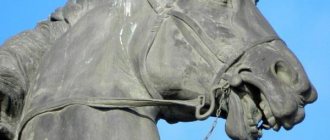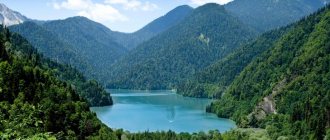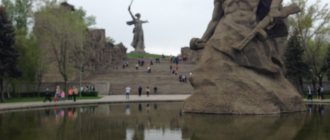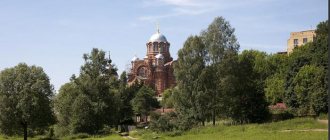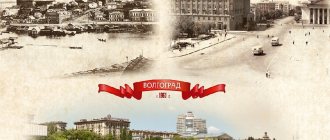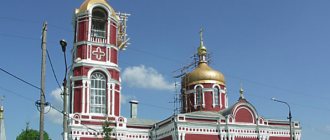The Great Patriotic War is the most terrible and destructive event not only for our people, but for all of humanity as a whole. Today, on the territory of our Motherland, there are many complexes and monuments dedicated to those terrible events. But the largest and largest is considered to be Mamayev Kurgan, which is located in the center of Volgograd. It is here that the monument-ensemble “To the Heroes of the Battle of Stalingrad” is located. Every resident of our country should definitely visit this memorable and atmospheric place
Historical data
From history textbooks we know that, starting in the 17th century, Russia expanded into the resource-rich lands located beyond the Ural ridge. At first, these were small Cossack detachments that pushed the Khan’s army into the depths of Siberia. And today thousands of tourists want to get to Kurgan. The sights of the city will not leave anyone indifferent.
Colonization did not bypass the territory of the current Kurgan region, which was once inhabited by Bashkirs, Kalmyks, and Kazakhs. The first Russian settlement was built near the Tsarev Kurgan, near which the Tobol River flows. The location for the Tsar's settlement was chosen for a reason; it was a strategically important point. From time to time, the settlement was destroyed as a result of raids by local Kazakhs. However, the village was restored each time by its inhabitants.
Tsarev Kurgan was a truly enormous bulk structure. In the 60s of the 20th century, local authorities considered its further existence unnecessary. Thus, the historical name remained from the giant mound. At the same time, it was decided to preserve other attractions for posterity.
Almost 100 years after its founding, in 1782, the settlement acquired the status of a city, which consisted of the Old and New Towns. The first of them was inside the second. The old city is represented by the Kremlin, the gates of which are quite reliable, since they were double. In the New Town, in addition to residential buildings, there were warehouses with military equipment, military barracks, and a gunpowder cellar. The outside was protected by 8 very powerful bastions, behind which an additional wide ditch was dug around the city.
Governor-General Kashkin’s great merit in the radical reconstruction of Kurgan. According to the master plan they developed, at the end of the 18th century it was planned to divide the city into quarters, and those consisted of streets. The Tobol River, or more precisely the direction of its flow, served as a landmark for the buildings. Rich townspeople could afford to build houses made of stone; the rest of the population settled in wooden buildings. The industry of that time was represented by three forges, one soap factory and two tanneries. One parish is organized for church services.
It took another hundred years for the city to become a trading center where one could buy bread, butter, lard and meat. Industry mainly existed at the expense of raw materials supplied by agricultural producers. This is how the city of Kurgan developed. The sights of the settlement should be seen by everyone who finds themselves in this area.
The Trans-Siberian Railway project served as a significant impetus for the development of the city, and its new life began. This period was marked in the history of the city by the construction of more than sixty factories and factories, and a new direction in gardening appeared - growing tobacco. Kurgan developed at a rapid pace. The sights of the city will be of interest to everyone who loves museums and monuments.
At the beginning of the 20th century, the first plant in Russia producing water turbines was launched. Literally from the first days of the Great Patriotic War, according to the historical order of the country's leadership, enterprises were transported from the western regions to Kurgan, as well as to many other cities of the Trans-Urals, and quickly put into operation. This circumstance contributed to the emergence of Kurgan as a huge industrial center with developed medical and educational institutions.
Presentation “Architecture of Kurgan”
Explanatory note for the presentation “ARCHITECTURE OF THE KURGAN”
1 slide. Architecture of Kurgan.
2 slide
. The history of the city of Kurgan originates from the settlement of Tsarevo Gorodishche. It was founded in 1679 by the investor of the Dalmatovsky Assumption Monastery Timofey Nevezhin at the foot of the ancient mounds. In 1782, in connection with the formation of the Tobolsk province, by Decree of Empress Catherine II, the settlement received the status of a city with the name Kurgan.
In 1785, the city was assigned a coat of arms, the description of which said: “... in a green field there are two silver mounds: after the name of this city and as a sign that they are located near the city itself.”
During tsarist times, the small town became a place of exile. He saw Polish rebels, Decembrists, Narodnaya Volya. The history of the city changed after the construction of the Great Siberian Railway, which ran through Kurgan in 1894. From a quiet county town by the beginning of the 20th century. Kurgan turned into one of the large commercial and industrial centers of the Urals and Siberia, known outside the Russian Empire.
The Kurgan region took its place on the map of Russia during the Great Patriotic War. On February 6, 1943, the city of Kurgan became the administrative center of the newly created Kurgan region.
For success in economic activity in 1982, Kurgan was awarded the Order of the Red Labor
Banner.
3 slide
. Modern Kurgan is a city covering an area of 372 km², with a population of about 340 thousand people. In recent years, new residential neighborhoods, multi-story high-rise buildings, shopping and entertainment centers, and sports facilities have been built here.
The city's architecture successfully combines styles from different eras. The central part of the city is decorated with monuments
history and architecture of the 18th-20th centuries: merchant houses and estates, monuments of wooden architecture,
Cathedral of St. Alexander Nevsky. The visiting card of the city is the architectural ensemble of the Central Square of Kurgan, created in the 50s of the 20th century. Leningrad architects and designers. There are many beautiful and unique places in Kurgan that are treasured by residents and admired by visitors. Every corner here has its own history.
4 slide. Historical and architectural monuments
5 slide. Administrative building of the distillery of D. I. Smolin
Kuibysheva, 122
The house was built in 1884 according to the design of the architect Yu. I. Ivashev. One building housed residential
house and office of a distillery with a store. The owner of the house was the founder of the family, one of the richest Trans-Ural merchants, Dmitry Ivanovich Smolin. The decor of the main facade consists of small
details reproducing the motifs of Russian wooden carvings, translated into stone. The site is currently being redeveloped. A recreation area has been organized on the site of the former courtyard, and a park has been laid out in front of the house. The building houses a branch of a yeast production company.
6 slide. House of A. A. Danilushkin
M. Gorky, 170
The building belonged to a well-known contractor in Kurgan, Andrei Abramovich Danilushkin. The building in the Russian style, unique for the architecture of Kurgan, was built in 1882. The decoration of the facade is characterized by the use of motifs borrowed from ancient Russian architecture.
Slide 7
House of the Decembrist A.E. Rosen
Sovetskaya, 67
The estate was built at the beginning of the 19th century, and in 1833 it was acquired by the Decembrist Andrei Evgenievich
Rosen, who is settling in Kurgan with his family. Since the end of 1890, the house housed the Public Assembly, which after the revolution was renamed the People's House. Now in the house of the Decembrist
Rosen is the Children's Art School No. 1.
8 slide. House of engineer F. F. Ostapets
Pushkina, 85
The elegant structure is an example of a residential log house made in the Art Nouveau style.
Erected by order of retired warrant officer Fyodor Fedorovich Ostapts at the beginning of the 20th century. Now in the house
The City Culture and Leisure Center is located.
Slide 9 House of merchant K. M. Dunaev
Klimova, 47
A unique example of a chopped wooden house. The building is distinguished by a façade decor with many
small carved parts. Built in 1906 by merchant Konstantin Markovich Dunaev. The building was restored in 1980. Now it houses the art department of Children's Art School No. 1.
10 slide. Fire station
Kuibysheva, 62
firebrigade9.narod.ru
The fire department building was built in 1882. In 1998, a wooden tower 27 meters high,
previously destroyed, it again decorated the fire station and gave it architectural completeness. Today, the tower, like the building itself, is an architectural monument and one of the symbols of the city of Kurgan.
11 slide. Union of Siberian Butter-Making Artels
Kuibysheva, 57
At the beginning of the 20th century. the house belonged to the merchant Pavel Vasilyevich Sokolov. Since 1912 it was located here
Union of Siberian butter-making artels, founded in 1907 by merchant Alexander Nikolaevich
Balakshin.
12 slide.
Photo by I. M. Babykin
Kuibyshev, 65
In 1927, the house housed the salon of the talented photographer Ippolit Mikhailovich Babykin.
Currently, the house has been restored according to drawings from the early 20th century. To this day, there is Photograph No. 1 of the city of Kurgan and a museum of the history of photography.
Slide 13 Cathedral of St. Alexander Nevsky
Volodarsky, 42
The Alexander Nevsky Church is considered one of the most beautiful buildings in the city and is listed in
Encyclopedia Britannica as an outstanding architectural monument. Construction of the church has begun
in 1896 according to the design of the talented Kurgan architect N. A. Yushkov. In 1929 the church was closed,
and in 1991 it again opened its doors to parishioners.
Slide 14 Museums
Slide 15 Regional Museum of Local Lore
Pushkina, 137 (+7 gukokm.narod.ru
The largest repository of historical, cultural and natural science collections in the Kurgan region. The museum has over 200 thousand museum objects. These are 40 collections covering the period from the primitive communal system to the present day. Unique exhibits of regional and federal significance are presented. The museum includes branches: the Decembrist House Museum, the V. K. Kuchelbecker House Museum, the City History Museum, the Aviation Museum and the T. S. Maltsev House Museum, located in the village of Maltsevo, Shadrinsky district, Kurgan region.
16 slide. House-Museum of the Decembrists
Klimova, 80 A (+7 gukokm.narod.ru
Opened in 1975 in the house where Decembrist Mikhail Mikhailovich Naryshkin lived since March 1832. The museum has restored the interiors of the owners' rooms, living room, dining room and library. The museum exhibits more than 2 thousand exhibits telling about the life of the Decembrists in Kurgan. One of the halls of the museum reveals the ideology of the Decembrist movement, tells about the uprising on Senate Square and the events that followed - the years of hard labor and imprisonment
Slide 17 Aviation Museum
Gagarina, 41a (airport) (+7 aviakurgan.narod.ru
Branch of the Kurgan Regional Museum of Local Lore. Founded in 1985. The museum building houses an exposition of the history of civil aviation, and on the museum grounds - military, civil and sports aviation equipment, which includes 14 aircraft. The Aviation Museum is the only museum of the Ministry of Culture of the Russian Federation of this profile. One of the most popular events of the museum is a large display of aviation equipment - “Open Cockpit Day”, which is held annually on City Day and Russian Air Fleet Day.
18 slide. Museum of the History of the City of Kurgan
Kuibysheva, 69 (+7 gukokm.narod.ru
The museum is located in a merchant mansion that belonged to the merchant of the 1st guild S. Berezin. Architectural monument of the 19th century. This is the only stone urban-type estate in the Trans-Urals that has preserved a closed courtyard with outbuildings and a central house in the style of Russian classicism. The museum exhibition reflects the political, economic, socio-cultural aspects of the development of Kurgan, starting from the founding of Tsarev Settlement until 1917, and also reveals the significance of the district town in the history of Siberia. A rare collection of photographs depicting the pre-revolutionary Kurgan, taken by the photographer of the last century A. Kocheshev, is presented in full.
Slide 19 Regional cultural and exhibition center
Gogolya, 30 (+7 okvc.kurganobl.ru
The center's activities consist of two directions: exhibition and cultural and leisure. The center hosts exhibitions of a wide thematic focus at the regional, Russian, and international levels; art exhibitions and anniversary expositions. Within the walls of the center there are clubs, lectures, master classes, creative meetings, theme evenings and presentations.
20 slide. Regional Art Museum
Gorky, 129 (+7 kohm.ru
The only museum in the region that has a collection of works by Russian artists of the 20th - early 21st centuries. The museum has a unique collection of watercolors, representing a 100-year period of its development. The decorative and applied arts section consists of works of traditional crafts of Russia and artistic crafts of the Trans-Ural region. Russian culture of the 18th - early 20th centuries. represented by icon painting, metal plastic, old printed and handwritten books. The museum conducts active exhibition activities and participates in the development and implementation of various scientific and educational projects.
21 slides. Theaters
22 slide. State Drama Theater
Gogolya, 58 (+7 kurgandrama.ru
The theater was founded in 1943. Since 1953 it has been located in a building erected according to the design of the Moscow architect K. Fedorov. The theater's repertoire, based on Russian classics, includes plays, vaudevilles, melodramas, and works by contemporary authors. Each theater season the repertoire is replenished with new performances. The theater team is a living creative organism, constantly searching for new theatrical forms, striving to preserve traditions and introduce new things in working with the classical repertoire.
23 slide. Puppet theater "Gulliver"
Sovetskaya, 104 (+7 gulliver45.ru
One of the oldest puppet theaters in the country. The theater's activities cover several areas: performances for children, performances for adults, original works of theater actors and innovative directors, combining music, puppets and drama. The Gulliver Theater is a collective member of the International Union of Puppet Theater Workers, a multiple laureate and diploma winner of international and Russian festivals. The theater is located in a historical building. The poet S. Vasiliev was born in this house on the former Dvoryanskaya Street.
24 slide. Regional Philharmonic
Troitskaya Square, 1 (+7 kurgan-filarmonia.ru
The Philharmonic building is rightfully considered a landmark of the regional center. The Big and Chamber halls, a huge stage and an orchestra pit made it possible to hold concerts of the most famous pop stars, orchestras, choirs and choreographic groups. The Philharmonic has a brilliant creative composition. The festival named after D. Shostakovich and the project “Musical Offering” with the participation of the State Symphony Orchestra named after E. F. Svetlanov have become traditional for Kurgan. A professional recording studio has been opened at the Philharmonic.
25 slide. Monuments and sculptures
26 slide. Monument to the labor glory of Kurgan railway workers
On the Valery Sobanin Square, near the railway station, there is a steam locomotive of the Felix Dzerzhinsky series - FD20-2697. From 1935 to 1957 it was driven by the famous Soviet driver, Hero of Socialist Labor Ivan Blinov. In 1980, he brought his locomotive to eternal parking in memory of the heroic work of Kurgan railway workers
Slide 27 Monument to V.I. Lenin
Monument to V.I. Lenin The monument was opened on October 27, 1967 on the square named after V.I. Lenin. The height of the sculpture is 6 m, with a pedestal - 13.5 m. The authors of the monument are architect G. Belyankin, sculptor V. Egorov
The monument was opened on October 27, 1967 on the square named after V.I. Lenin. The height of the sculpture is 6 m, with a pedestal - 13.5 m. The authors of the monument are architect G. Belyankin, sculptor V. Egorov
28 slide. Monument to L. B. Krasin
The monument to the revolutionary, the first Soviet diplomat, a native of Kurgan, Leonid Borisovich Krasin, was erected in 1978. The authors of the project are the artist Yu. Chernov, the architect G. Isaakovich.
Slide 29 Symbolic sign "Zero Kilometer"
»
The symbolic sign, located near the Main Post Office building, was inaugurated on the day of the 333rd anniversary of the city in 2012. It represents the figure of a 19th century postman. and a milestone, symbolizing the starting point of the road distances in the Kurgan region. The author of the project is the monumental artist B. Orekhov
30 slide. "Parents"
Since 2007, the sculpture has become a symbol of a long and happy family life for Kurgan; it is here that newlyweds come after marriage. The author of the work is the sculptor L. Laperdina.
31 slides
. I love Kurgan!
Houses of the Decembrists
There are many museums in the city, some of which are unique across the country. These, for example, include objects related to the Decembrists.
In one of these houses in 1845-1846. The Decembrist poet V.K. Kuchelbecker, a former lyceum student friend of Pushkin, lived with his family (wife and two children). In the house of the famous Decembrist, it was possible to restore the atmosphere of that time. Be sure to visit these attractions of Kurgan. Photos of the exhibition will not convey the entire atmosphere; these exhibits must be seen with your own eyes.
In 1975, in the house where the family of the Decembrist M.M. Naryshkin lived in the 30s of the 19th century, a museum was created, which is considered a branch of the regional local history museum. After all the rooms inside were completely restored (libraries, living room, dining room and master's room), the house acquired an almost original appearance. Craftsmen used Karelian birch and mahogany to make furniture. Among other items there are many bronze items, silverware and porcelain.
Historical houses of Kurgan: past and present
Summer is a time to travel and learn new things or remember forgotten old ones.
Many tourists and guests of our city, having visited Kurgan, note its pleasant feature - a large number of well-preserved ancient buildings. We invite you to plunge into history and remember what happened in five historical buildings of Kurgan in the past.
Alexey Ivanovich Kocheshev lived in this house - a man, thanks to whose photographs we can today see Kurgan as it was at the end of the 19th - beginning of the 20th century. The house was built around 1900. At first, many of the premises in this building were rented out, but after some time Kocheshev began to use the retail space for his own business - he opened a printing house in the house, a store of stationery and photographic goods. Even during its construction, the building was intended for photographic work - the premises of the house made it possible to take photographs in natural and artificial light. Kocheshev's house was distinguished by a huge inclined window in place of one of the facade walls.
Kocheshev became famous among Kurgan residents, in particular, for the fact that in 1913-1914 he organized photography that was more accessible to the people, where railway workers, military personnel and students, as well as, during the First World War, all those leaving for the front could be photographed at reduced prices.
In 1925, Kocheshev’s house was rented by the famous Soviet-era Kurgan photographer Ippolit Mikhailovich Babykin. After the revolution, the house was rebuilt, its appearance changed significantly. Now the building has been redeveloped again and is used as a residential building. Kocheshev's House is a cultural heritage site of regional significance.
A unique example of a residential building in the “Russian style”, dating back to ancient Russian architecture, in the architecture of Kurgan of the late 19th – early 20th centuries. Cultural heritage site of regional significance.
Andrei Abramovich Danilushkin came from the peasant class. He came to Kurgan with his family in the early 1880s from the Vladimir province. After the advent of the railway, when construction began in Kurgan, the Danilushkins became famous finishers in the city. In those same years, Andrei Danilushkin moved to the petty bourgeois class. Income allowed him to build a three-level mansion for his family in the 1890s, and Andrei Abramovich carried out most of the work personally, with the help of his sons. In one of the rooms on the top floor, at the request of Andrei Abramovich’s wife, all the walls were decorated with mirrors.
According to legend, it was in Danilushkin’s house that Admiral Kolchak spent the night in February 1919 when he visited Kurgan at the invitation of the Union of Siberian Butter-Making Artels. However, according to historian and local historian A.M. Vasilyeva, during his arrival in Kurgan, Kolchak spent the night in an armored train.
In the early 1920s, the second city outpatient clinic was located in Danilushkin’s house. Now the Center for Hygiene and Epidemiology in the Kurgan Region is located here.
Object of cultural heritage of federal significance. A unique example of chopped wooden architecture for Kurgan, preserved almost in its original form. A distinctive feature is the carved decor, which has no analogues among the wooden residential buildings of the city in terms of the abundance of motifs and elegance.
The Dunaev family was very famous in Kurgan. The Dunaevs owned one of the largest steam mills near the city, equipped with the latest technology, and received gold and silver medals at all-Russian exhibitions for the quality of flour. The merchant's son Konstantin Markovich Dunaev, who built this elegant house for his young wife, was elected a member of the city Duma, held many other honorary positions in the city, and even participated in a musical ensemble.
In 1919 the building was nationalized. On May 1, 1924, the Peasant House was opened in Dunaev’s house - they not only actively carried out cultural and political work, but also provided overnight accommodation and food to peasants from the surrounding villages. In the 1920s, it was here that the first Kurgan radio was installed.
In 1968, Dunaev’s house (after long adventures, because during this time the building managed to be a rooming house, a hostel, and a residential building) was included in the list of monuments of wooden architectural and folk architecture subject to protection, and in 1980 it was restored. Nowadays, students of the art department of Kurgan Art School No. 1 study in Dunaev’s house.
One of the oldest buildings of the late 18th century is a cultural heritage site of federal significance. The house for some time belonged to the Decembrist Mikhail Mikhailovich Naryshkin, who was in exile in Kurgan from 1833 to 1837.
A member of the Union of Welfare and Northern Society, Colonel of the Tarutino Infantry Regiment Mikhail Naryshkin was sentenced to 12 years of hard labor, then the term of hard labor was reduced to 8 years. Naryshkin arrived in Kurgan for a settlement together with his wife Elizaveta, having served hard labor. Thanks to the educated and hospitable hosts, the Naryshkin house became the center of the cultural life of Kurgan in the 30s of the 19th century. Decembrists and exiled Poles often met here, shared news, and listened to music. In the fall of 1837, by order of the tsar, Naryshkin, along with other Decembrists, was sent to the Caucasus to join the active army. After the Naryshkins left, the house changed several owners.
After the revolution, the house for some time housed the district land office and the agricultural museum. In 1924, the house was rented out as apartments, and in 1926 it served as a warehouse for agricultural machinery and implements. Later, the building successively housed a candy factory (1927), a milk processing plant (1929), a capo-stub workshop, the House of Pioneers (1935), a dormitory (1938), and a medical school (1940-1964). Now here is the House-Museum of the Decembrists, opened after the restoration of the building in 1975.
The small house, reminiscent of a fairy-tale castle with narrow and high windows and a turret on the roof, was built by Kurgan architect Alexander Basargin by order of retired warrant officer and railway engineer Fyodor Fedorovich Ostapts at the beginning of the 20th century. Cultural heritage site of regional significance. This is not a typical building for Kurgan - a striking example of a residential log wooden house in the Art Nouveau style.
Fedor Fedorovich Ostapets, a native of peasants, worked on the Siberian Railway as an assistant to the head of a section of the track and head of technical classes. In 1905, having bought a plot of land on Pushkinskaya Street, he decided to build a two-story house with eleven rooms and two warm toilets, heated by stoves of various types, of which there were more than a dozen in the building. But the owner did not live in his original home for long - in 1908 Ostapets sold the practically new house to forester Nikolai Rozanov, after which he and his family left Kurgan. Now this building houses the municipal institution “City Culture and Leisure Center”.
If you witness an interesting event, send messages, photos and videos to Viber and WhatsApp to phone number. : +79195740453, in our group “VKontakte”
Our Telegram channel
Vkontakte community
Yandex.Zen channel
Aviation Museum
The Museum of Aviation Technology is located on Gagarin Street and has been operating since 1985. It is considered unique and the only one in the entire Urals and Siberia. On its vast territory, covered with asphalt, with an area of 5.5 thousand square meters. m, there are various types of aircraft. They are represented by military ones - "Migami" and "Sushki" - and passenger ones - Ilyushin and Antonov.
This powerful complex is worth visiting Kurgan. Sights of this magnitude should be seen by all residents of Russia.
What are the residents of Kurgan proud of?
Views of Kurgan Photo: Ekaterina Sychkova
Kurgan was founded almost three and a half centuries ago (1679). According to legend, it received its name in honor of the mound on the grave of the beautiful daughter of a descendant of representatives of the Golden Horde, Khan Kadyr. Later, it was almost renamed Krasinsk in 1927 - after the name of a native of the city, the famous revolutionary Leonid Krasin. What to see in Kurgan and where it’s worth visiting - in the URA.RU material for the #YasUral project.
Zero kilometer
“Kilometer Zero” in the center of Kurgan
Photo: Igor Merkulov © URA.RU
You can start a city tour in its very center, especially since there is a special starting point here - “Zero Kilometer”. It is from this mark that the distances from Kurgan to other cities and villages in the region are measured. A border post with this mark is installed near the building of the main post office of the Trans-Ural region. At the post there is a postman with his usual bag.
And, of course, as soon as the monument appeared, signs appeared. They say that if you make a wish and rub your bag, it will certainly come true. They say it works flawlessly if you don’t receive news from a loved one or someone important to you for a long time.
Attraction address : st. Gogol, 44.
Park "Tsarevo Settlement"
The main feature of the park is the recreated watchtower and a fragment of the fortress wall, as they could have been built by the founders of the city themselves; they are worth seeing in person. In addition, you can take part in a folklore festival, learn the history of the city, and even have a photo shoot in folk costumes.
Address: Constitution Avenue 32a.
The park is worth visiting for guests of Kurgan
Photo: Igor Merkulov © URA.RU
Airplane Museum
You are the captain of an airship at the controls or a flight attendant smiling... at the smartphone screen. Such pictures will decorate any Instagram. And you can make them, as well as replenish your knowledge about civil and military aviation, the history of its development in the Trans-Urals, and find out what is filled with the pilot’s “alarm suitcase” at the Kurgan Aviation Museum.
The museum is 15 years old and is located near the airport. Here you can be on board real airplanes and helicopters, and try your hand at being a pilot - albeit on a flight simulator. There is a collection of pilot uniforms from different periods, and many photographs.
The museum's collection includes a front-line bomber, passenger and transport aircraft, fighter-interceptors, a multi-role aircraft, an MI-2 helicopter, an AN-2 maize truck and others. A visit to the museum will impress both children and adults.
The museum is located next to the airport
Photo: Igor Merkulov © URA.RU
Address: Gagarina street 41a.
In the city garden
You can see happy “Parents”, find the “Golden Ring” or stand at the “Meeting Place under the Clock” in the city park. In hot weather, it is worth walking by the fountain, admiring the flower arrangements in the flower beds and flowerpots, and roller skating along the paved paths. And also take interesting photos on the lovers’ bench, near the compositions “Advice and Love”, “Horseshoe” and others.
Address: st. Lenin. 23.
The city park is especially beautiful in summer
Photo: Igor Merkulov © URA.RU
Tobol embankment and Living Heart
If you decide to devote your day off not to getting to know the museum exhibitions, but just to relax and take a walk, then take a walk along the Tobol embankment. It has changed a lot over the past year and a half and has become a real recreation area. By the way, while walking along it, you can “talk” with the townspeople of the century before and last - you will be greeted by openwork sculptures of a young lady and a gentleman, a violinist, and regulars of discos of the 70s of the last century.
Renovated embankment in Kurgan
Photo: Igor_Merkulov © URA.RU
Renovated embankment in Kurgan
Cathedrals
The main one is the Cathedral of St. Alexander Nevsky. It was consecrated in 1902. The building is so beautiful that it was included in the Great British Encyclopedia.
Attraction address: Volodarskogo Street 42.
You can take amazingly beautiful pictures at the Epiphany Cathedral, built in the pseudo-Russian style. It is called the architectural pearl of Kurgan. If you are lucky, you will be able to listen to the ringing of bells - holidays are held here with the participation of the best bell ringers in Russia.
Kurgan Epiphany Cathedral
Photo: Ekaterina Sychkova © URA.RU
Fire Tower
A twenty-meter tower with a dome, called a tower, was built in 1877 as an “outpost” to monitor the fire situation in the city. For the Kurgan, which at that time was mostly made of wood, this was a very necessary structure. At the observation deck of the tower, Stepan, a mannequin dressed in a tarpaulin suit and a fireman’s helmet, is still keeping a 24-hour watch. The historical building itself houses, as it did almost a century and a half ago, a fire department.
By the way, in Kurgan there is also a museum of the Fire Propaganda Center, where they will tell you about the formation and development of fire fighting both in Russia and in Kurgan.
Attraction address: st. Kuibysheva, 62.
Photo: Igor Merkulov © URA.RU
Bread Museum
Siege bread, bread from outer space, tillage tools - all this is collected in the only bread museum in the Urals. More than a thousand exhibits in three halls tell about agriculture, about the work that people put into a piece of bread. One of the exhibitions is dedicated to the life and work of People's Academician of the All-Russian Academy of Agricultural Sciences Terenty Semenovich Maltsev. The museum, located in the premises of boarding school No. 25, contains some of the personal belongings of the famous grain grower.
Attraction address: Pirogova str., 17.
Museum of Photography No. 1
An elegant and unusual two-story wooden mansion with a glass roof is a copy of a house built in the 20s of the last century by Ishim photographer Ippolit Babykin, who moved to Kurgan. It was a photographic studio in which the faces of thousands of citizens were captured. However, even today it retains its original task. Sergei Reutov, who restored the building, organized here, along with a photo studio, a photography museum, which contains more than 2.5 thousand exhibits. Here you can see how photographic technology developed and rare photographs.
Attraction address: st. Kuibysheva, 65.
Books of Giants and Lilliputians
Do you want to see books weighing 10-20 grams or “tall” one meter? Admire antique tomes bound in wood or leather? See the armorial bookplates of the Prussian royal house, the ownership marks of the persons of the Russian imperial family? Then take a look at the Book Museum, located in the building of the scientific library named after. A.K.Yugova.
Attraction address: st. Komsomolskaya, 30.
Alexander Nevsky Cathedral
The decision to build the temple was made in the winter of 1895. The bulk of the funds were donated by honorary citizen merchant D.I. Smolin. Other merchants and parishioners also contributed. As a result, with the money collected from the people, the temple of Prince Alexander Nevsky was built and consecrated on June 22, 1902.
In fact, it functioned until 1929. Then, over the years, a museum was organized here, converted into a gym, the Faculty of Mechanization of the Higher Party School, a clothing warehouse, and a planetarium. Only during the period of perestroika it was decided to use it for its intended purpose - the religious building was returned to the Orthodox community. Since the summer of 1989, the building began to be restored and revived. In 1993, the Alexander Nevsky Temple became a cathedral.
Monuments in the city of Kurgan
The monument to the famous hero of the beloved Soviet film “White Sun of the Desert” was installed where it should have been – opposite the customs building. Immortalized in granite, Pavel Vereshchagin has been here since 2007 thanks to the efforts of customs officers who spared no personal savings for him. Popular Russian customs officer Vereshchagin constantly reminds his colleagues that they must be decent and not give in to the temptation to take bribes.
Zero Kilometer is a kind of analogue of those monuments that are installed in some Russian settlements and around the world. A life-size postman cast in bronze stands on the zero kilometer of highways near the main post office. Its opening is timed to coincide with the historical date - the 333rd anniversary of the founding of the city of Kurgan.
Puppet theater "Gulliver"
The creation of the Kurgan Puppet Theater was conceived during the Great Patriotic War, at the end of the summer of 1943. However, the theater troupe did not have a building for a long time; the performances were on-site. In 1948, puppeteers were sheltered by the regional philharmonic society.
And the year 1949 was marked in the life of the theater troupe with the premiere of the play “The Scarlet Flower,” which took place on the puppet theater’s own stage. Over the entire period of creative activity, the troupe has been recognized as one of the best not only in Russia, but also in France.
The Gulliver Puppet Theater deserves to be called a landmark of Kurgan, for the reason that it is one of the first cultural institutions of this kind. Everyone who finds themselves in Siberia should look at Kurgan. The sights of the city will appeal to anyone who loves old buildings and interesting monuments.
Mamayev Kurgan in Volgograd
There is another place in Russia called a mound. On the right bank of the Volga River in the Central district of the city of Volgograd is located Mamayev Kurgan. Sights of this magnitude are revered by all residents of our large country. It was here that fierce battles took place during the Battle of Stalingrad.
For this place, many people strive to visit Volgograd. Sights - Mamayev Kurgan, Motherland Calls - military in nature. On the territory there are graves of soldiers who fought for the country and were killed in these brutal battles.
Past the hill
For many years, Mamaev Kurgan has been “guarding” the local surroundings. On front-line maps it was simply designated “height 102.0.” But for the soldiers of the 62nd Army Unit and their commander, there was something more behind it. Maintaining altitude is a matter of life and death. From the top there was a view of the city center, the port, the train station, the industrial part, and the crossing of the Volga. The position made it possible to control almost all of Stalingrad.
Mamayev Kurgan, hill PHOTO: fullpicture.ru
The battle for Mamayev Kurgan lasted for 135 days out of 200 of the Battle of Stalingrad. During this time, the mound has seen a lot. Soviet soldiers were shelled around the clock and were constantly bombed from the air. In a difficult battle, victory came at a huge price. According to data, more than a million people died, and the city was almost completely destroyed. From all over Stalingrad, dead soldiers were buried on the hill. The hill, burned and scarred by trenches and craters, remained black, as if charred, even in winter. In the spring, grass failed to grow on the burnt-out Mamayev Kurgan.
